|
Give Me Your Tired,
Your Poor,
Yearning to be Free
by Bob Brooke
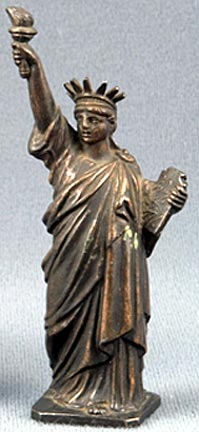 While
all collectors have love affairs with the objects they collect, none are
more passionate than those who collect Statue of Liberty memorabilia. To
these collectors, their collections are more than a mere assemblage of
objects. Each represents a collector’s passion for Liberty’s history and
her cultural significance. For most collectors, it’s Miss Liberty’s
symbolism that grabs them. While
all collectors have love affairs with the objects they collect, none are
more passionate than those who collect Statue of Liberty memorabilia. To
these collectors, their collections are more than a mere assemblage of
objects. Each represents a collector’s passion for Liberty’s history and
her cultural significance. For most collectors, it’s Miss Liberty’s
symbolism that grabs them.
Although the French Government conceived the Statue of Liberty as a
symbolic gesture, no one had any idea at the time just how important a
symbol she would become. Frederic Auguste Bartholdi, her creator,
envisioned her as a monument to the mutual love of the French and
Americans for liberty, and as propaganda against the then conservative
leaders of the French government. It was thought that building a huge
monument for the United States would forever link that powerful
democratic country, with France, and cement that country's new Third
Republic. But not everyone shared Bartholdi's vision.
Fundraising, especially in the United States, proved difficult. The
Statue of Liberty Committee had planned to unveil that the statue would
be unveiled in 1876 for the Centennial of American Independence. But
sluggish fundraising delayed the gift for at least 10 years. This
resulted in a variety of wonderful memorabilia. Most souvenirs sold for
pennies to dollars
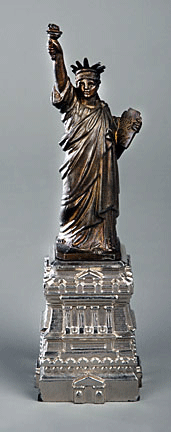 each
to raise money to complete the big statue and bring her to America. The
French, on the other hand, raised money to complete the building of the
statue piece by piece while the Americans raised funds to complete the
gigantic base. By 1884, The French had completed Miss Liberty and were
ready to ship her. But the American Committee was short the $100,000
needed to complete her pedestal. To raise additional monies, the
Committee commissioned more than 100,000 models which it sold by
subscription, and at Macy's and other department stores. Each $1
purchase added to the Liberty coffers. It sold some 12-inch models for
$5. Today, the small metal models sell for $250 to $300 and the large
ones from $500 to $1,000. each
to raise money to complete the big statue and bring her to America. The
French, on the other hand, raised money to complete the building of the
statue piece by piece while the Americans raised funds to complete the
gigantic base. By 1884, The French had completed Miss Liberty and were
ready to ship her. But the American Committee was short the $100,000
needed to complete her pedestal. To raise additional monies, the
Committee commissioned more than 100,000 models which it sold by
subscription, and at Macy's and other department stores. Each $1
purchase added to the Liberty coffers. It sold some 12-inch models for
$5. Today, the small metal models sell for $250 to $300 and the large
ones from $500 to $1,000.
Meanwhile, the French disassembled the statue into over 300 pieces and
shipped it in more than 200 wooden crates. The arm bearing the torch
filled 21 boxes alone. On June 17, 1886, she arrived. Workers placed the
statue on the immense supporting monument designed by Richard Morris
Hunt. On Oct. 28, 1886, the Committee officially installed and dedicated
the Statue of Liberty. There was a huge inaugural parade and President
Grover Cleveland delivered a dedication address. Collectors covet the
programs, tickets, and invitations from this gala occasion.
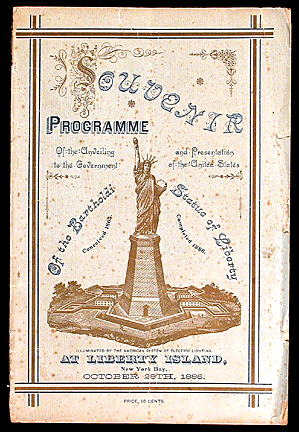 During
the celebration, President Cleveland led a flotilla of 250 ships to
Bedloe's Island. Ironically, women were banned from participating in the
dedication ceremony even though it was a woman's form Liberty was
modeled after. Bartholdi said that he modeled the face of Miss Liberty
after his mother's face and the arms after those of his wife. Angry
suffragists circled Bedloe's island in a rented boat during the
dedication, announcing through a megaphone that if Liberty got down off
her pedestal, she wouldn’t have been allowed to vote either in France or
America, both of which prided themselves on being democratic republics. During
the celebration, President Cleveland led a flotilla of 250 ships to
Bedloe's Island. Ironically, women were banned from participating in the
dedication ceremony even though it was a woman's form Liberty was
modeled after. Bartholdi said that he modeled the face of Miss Liberty
after his mother's face and the arms after those of his wife. Angry
suffragists circled Bedloe's island in a rented boat during the
dedication, announcing through a megaphone that if Liberty got down off
her pedestal, she wouldn’t have been allowed to vote either in France or
America, both of which prided themselves on being democratic republics.
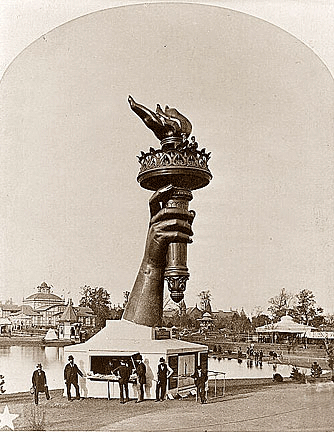 During
the earliest Liberty years, many souvenirs appeared. During the 10 years
before Liberty arrived, many publishers printed lithographs, including
early pieces of sheet music. There are stereopticon photos from the 1876
Centennial Exhibition in Philadelphia of Liberty’s right arm, which
appeared at the fair, showing visitors standing on her torch. These
souvenirs now sell for $125. Visitors to the fair could purchase large,
finely detailed bronze medals, crafted in Paris. During
the earliest Liberty years, many souvenirs appeared. During the 10 years
before Liberty arrived, many publishers printed lithographs, including
early pieces of sheet music. There are stereopticon photos from the 1876
Centennial Exhibition in Philadelphia of Liberty’s right arm, which
appeared at the fair, showing visitors standing on her torch. These
souvenirs now sell for $125. Visitors to the fair could purchase large,
finely detailed bronze medals, crafted in Paris.
In 1878, Liberty had no body, but when Europeans gathered in Paris for
the 1878 Expeditions, the head had been completed and was displayed on
the banks of the Seine. Visitors filled her crown and for several
francs, could take home a lovely 4-inch Liberty bust, a few of which
found their way to America and today sell for upwards of $500. Other
French souvenirs included tasseled, silks and ribbons made for the fair
by B.B. Tilt & Son in Paterson, New Jersey.
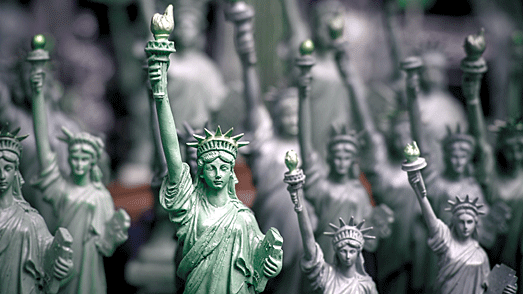
For a substantial contribution to aid French fundraising, up to 100 zinc
statuettes went on sale, including a small edition, finely detailed
statuette in terra cotta, hand-finished by Bartholdi, himself. During
the 1986 Liberty Centennial, several of these reached more than $100,000
at auction. In the United States, a New Jersey furniture maker named
Follmer, cast a few detailed zinc statuettes carrying 1883 and 1885
patent dates. These are quite rare, much more so than the American
Committee Models. Follmer's statuettes feature the original Hunt
pedestal design that the Committee ultimately abandoned for the one
actually under Liberty's feet. Today, these statues sell for over
$5,000.
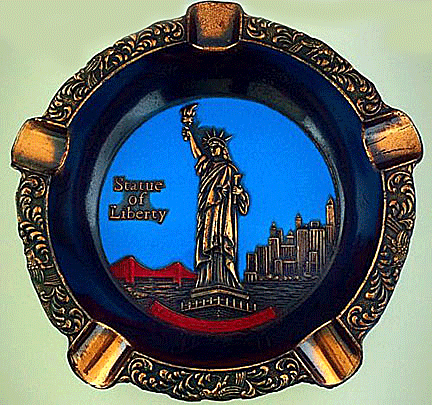 The
20th century witnessed many more souvenirs—some as works of art, some as
advertising, some as satirical commentaries, some as cheap souvenirs for
the hordes of tourists who visited her. Practically everything had the
image of Miss Liberty reproduced on it, including clocks, lamps,
statuettes, compacts, cigarette cases and boxes, cookie tins, pitchers,
spoons, china and even trade cards satirizing Liberty in order to sell a
product. Though some of objects were beautifully done, others appear
cheap with muddied facial features and poor workmanship. But even the
cheap ones are collectible. The
20th century witnessed many more souvenirs—some as works of art, some as
advertising, some as satirical commentaries, some as cheap souvenirs for
the hordes of tourists who visited her. Practically everything had the
image of Miss Liberty reproduced on it, including clocks, lamps,
statuettes, compacts, cigarette cases and boxes, cookie tins, pitchers,
spoons, china and even trade cards satirizing Liberty in order to sell a
product. Though some of objects were beautifully done, others appear
cheap with muddied facial features and poor workmanship. But even the
cheap ones are collectible.
Many collectors began their collections while they were teenagers after
a class trip to New York and a visit to the Statue of Liberty. Often
this visit brought back memories of grandparents who came to the United
States from some foreign country. While visiting, they would visit the
gift shop and be awed by all the Statue of Liberty souvenirs.
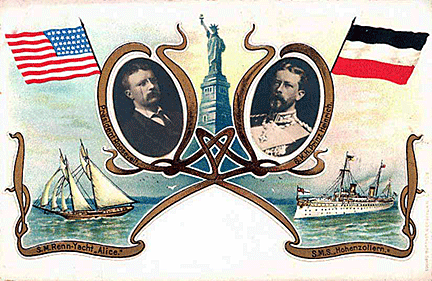 It’s
important to know how to tell really early Liberty collectibles, that is
before 1891, from more recent examples. The first step is to look at the
pedestal on which Liberty stands. Early items are characterized by the
early pedestal design that was subsequently rejected for the final base
we are familiar with today. The early pedestal looked somewhat like a
fortress, with high, small porticos, studded with protruding bricks.
Familiarize yourself with the difference between the two and you will be
able to spot valuable older pieces when others might pass the them by . It’s
important to know how to tell really early Liberty collectibles, that is
before 1891, from more recent examples. The first step is to look at the
pedestal on which Liberty stands. Early items are characterized by the
early pedestal design that was subsequently rejected for the final base
we are familiar with today. The early pedestal looked somewhat like a
fortress, with high, small porticos, studded with protruding bricks.
Familiarize yourself with the difference between the two and you will be
able to spot valuable older pieces when others might pass the them by .
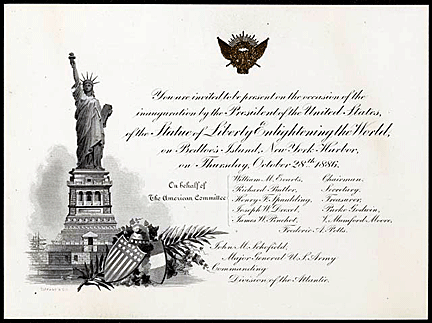 Another
way to identify older items, particularly ephemera, is to look for
pieces titled, "The Great Bartholdi Statue" or "Liberty Enlightening the
World" instead of the title Statue of Liberty. Another
way to identify older items, particularly ephemera, is to look for
pieces titled, "The Great Bartholdi Statue" or "Liberty Enlightening the
World" instead of the title Statue of Liberty.
During the Liberty Centennial in 1986, there was a rush of interest in
Liberty collecting. At that time, there were thousands of souvenirs and
"limited editions" sold, including watches, medals, limited-edition
plates, rugs, cookie jars, mugs, and jewelry.
Most collectors agree that, although items are becoming more scarce,
there are still plenty of finds if you look. Garage sales, flea markets,
thrift shops and Goodwill stores are all good places to find Statue of
Liberty souvenirs.
< Back
to Collectibles Archives
Next
Article >
|
